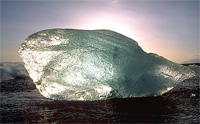Difference Between Ice and Water

Water, commonly known by its chemical properties as H2O, is one of the most prevalent elements on the Earth, with up to 75% of the Earth’s surface being covered with it. It is among the most essential requirements for life to exist, and has practical applications for nearly every industry one can think of.
A water molecule is formed when two hydrogen atoms and one oxygen atom is covalently bonded to each other. Water, in its natural state, exists as a liquid. The hydrogen atoms inside the water molecules are not sufficiently close; hence the hydrogen bonding between the molecules is constantly forming and breaking. This causes water to lack a distinct structure, and gives it its fluid appearance. In its liquid state, a water molecule is on average only hydrogen-bonded to approximately 3.4 neighbouring water molecules at any one time. The density of liquid water is 1.00 g/cubic cm.
In contrast, ice is the solid form of water. Ice has a rigid lattice structure, in a tetrahedral crystalline form which resembles giant molecular elements. Its appears in various forms, such as in hard amalgamated crystals like ice cubes, or loosely accumulated granules like in snow. Unlike liquid water, hydrogen bonding plays a stronger role in the density and shape of ice than the covalent bonds as the water molecules are pressed against each other very closely. This causes the repelling nature of like-like charges to overcome the forces of attraction in the structure, causing ice to exhibit the unusual characteristic of becoming less dense as it cools, where conventional wisdom declares that the lower the temperature the denser a matter becomes. The density of ice is 0.931 g/cubic cm. This is why ice floats in water. In ice, each water molecule is hydrogen-bonded to 4 other water molecules.
Ice and liquid water may possess the same nature, but they can be used for very different purposes. Ice is commonly used to preserve foods because it is cold, and water’s high enthalpy of fusion allows it to absorb heat from other things effectively, thus delaying the activity of bacteria and microorganisms. Liquid water, on the other hand, is seen as a cheap alternative to heating solutions at night, as they can absorb heat from the sun during the day and release it at night.
Ice and liquid water are essential items that help tremendously in our daily lives, and understanding how they work and behave will surely be beneficial to us all in the long run.
- Difference Between Schizophrenia and Psychosis - March 7, 2024
- Difference Between African and Asian Elephants - March 7, 2024
- Difference Between Sunscreen and Sunblock - February 15, 2024
Search DifferenceBetween.net :
 Email This Post
: If you like this article or our site. Please spread the word. Share it with your friends/family.
Email This Post
: If you like this article or our site. Please spread the word. Share it with your friends/family.
4 Comments
Trackbacks
- Difference Between Buddhism and Hinduism | Difference Between
- Difference Between Plasma And Serum | Difference Between
- Difference Between Water and Alcohol | Difference Between | Water vs Alcohol
- Difference Between Sumerians and Egyptians | Difference Between | Sumerians vs Egyptians

